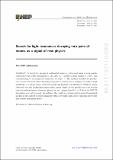Search for light resonances decaying into pairs of muons as a signal of new physics
Author(s)
The CMS Collaboration
DownloadPublished version (719.6Kb)
Terms of use
Metadata
Show full item recordAbstract
A search for groups of collimated muons is performed using a data sample collected by the CMS experiment at the LHC, at a centre-of-mass energy of 7 TeV, and corresponding to an integrated luminosity of 35 pb-1. The analysis searches for production of new low-mass states decaying into pairs of muons and is designed to achieve high sensitivity to a broad range of models predicting leptonic jet signatures. With no excess observed over the background expectation, upper limits on the production cross section times branching fraction times acceptance are set, ranging from 0.1 to 0.5 pb at the 95% CL depending on event topology. In addition, the results are interpreted in several benchmark models in the context of supersymmetry with a new light dark sector exploring previously inaccessible parameter space.
Date issued
2011Department
Massachusetts Institute of Technology. Department of Physics; Massachusetts Institute of Technology. Laboratory for Nuclear ScienceJournal
Journal of High Energy Physics
Publisher
Springer Science and Business Media LLC
Citation
Chatrchyan, S., et al. "Search for Light Resonances Decaying into Pairs of Muons as a Signal of New Physics." Journal of High Energy Physics 7 (2011).
Version: Final published version